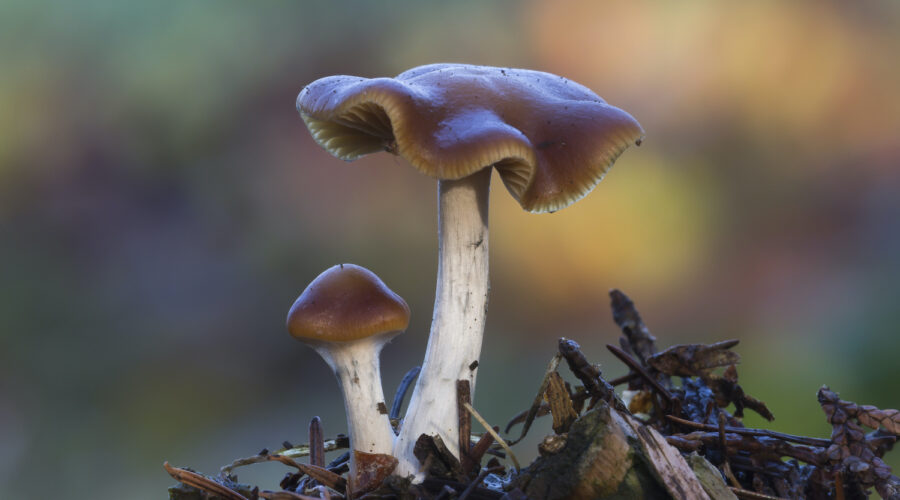Wavy Cap Mushrooms – The Magic Mushrooms with the Deadliest Look-ALikes
Wavy cap mushrooms (Psilocybe cyanescens), also known as “wavy caps”, are a highly potent species of psilocybin mushroom. They are known as “blueleg brownie mushrooms” in the UK. The name “blueleg” part of the name comes from the fact that the stem bruises blue when handled, while the “brownie” part refers to the brown color of the cap.
Wavy caps may not be as commonly used as other types of psilocybin mushrooms, such as Psilocybe cubensis and its varieties, but many users seek them out for their high potency.
RELATED: 10 Most Potent Magic Mushrooms
Identifying Wavy Caps
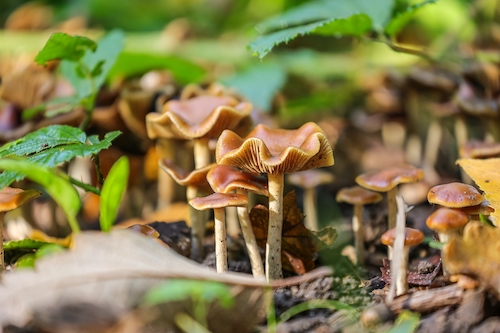
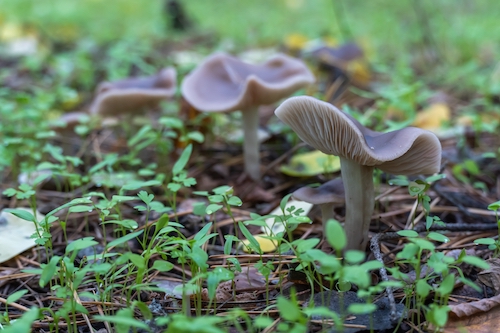
It should first be noted that wavy caps grow in the wild. If you want to source them by picking them (rather than buying them from someone), you need to know what they look like.
After all, wavy cap mushrooms have some lookalikes that you definitely don’t want to pick and eat. Some of these are highly poisonous and eating them can make you feel very sick and, if not treated quickly, may be fatal.
Exciting news: Oregon is legalizing Psilocybin therapy in early 2023. Click here to get on the waiting list for the first state-approved psilocybin therapy in the United States now!
How To Identify Wavy Cap Mushrooms
You’ll be able to identify wavy caps by knowing the distinctive features of the mushroom, which are as follows:
- Cap (pileus). Caramel to chestnut-brown when moist, fading to pale buff or slightly yellowish when dried. The caps measure from 1.5-5 cm across and are distinctly wavy in maturity (hence the name wavy caps). The color of the cap is rarely seen in mushrooms other than Psilocybe cyanescens. The cap can stain blue when touched or otherwise disturbed. The caps are sticky to the touch, owing to an outer gelatinous layer called a pellicle.
- Gills (lamellae). The gills underneath the cap are adnate (broadly attached to the stem), and light brown to dark purple in maturity with lighter gill edges. The gills, like the cap, can stain blue if touched.
- Veil. The mushroom has a cobweb-like partial veil that peels away as the cap matures and expands, leaving an annular zone around the stem that is sticky and often turns purple-black due to the presence of spores.
- Stem (stipe). Fibrous, white when young, turning grey-brown as the mushrooms mature.
- Odor and Taste. Farinaceous (“flour-like”).
Wavy Caps Very Deadly Lookalikes
Beware of the Genus Galerina

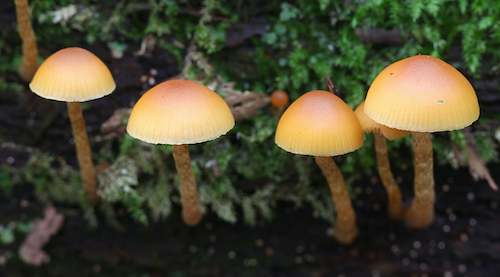
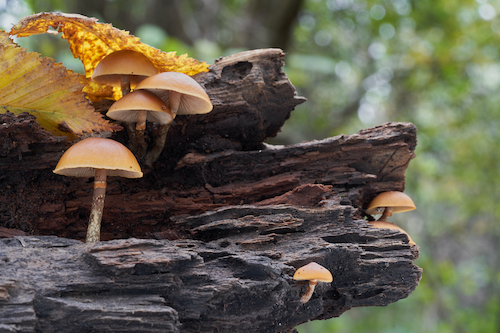
Psilocybe cyanescens has some lookalikes that you should be aware of. The ones that should cause caution are species from the genus Galerina, which can be deadly due to the presence of amatoxins (poisons unique to fungi).
After ingesting amatoxins, people may feel sick within a couple of hours, then recover a few hours later, whereas others experience no symptoms at all. During this time, however, the amatoxins begin causing damage to the liver and kidneys. If individuals don’t receive treatment, then around two days after the poisoning, they can start to feel weak, then very ill, and soon after that, experience organ failure.
Galerina species, such as Galerina marginata (also known as deadly skullcap, autumn skullcap, or deadly galerina), resemble young specimens of Psilocybe cyanescens with their caramel-brown cap. The difference is that they have a brown stem with an annulus. They are poisonous and potentially deadly, as they contain amatoxins.
RELATED: Here’s How Much Psilocybin Retreats Cost
Also Watch Out for Cortinarius, Hypholoma, and Leratiomyces
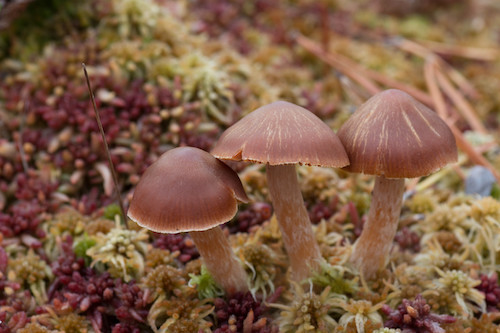
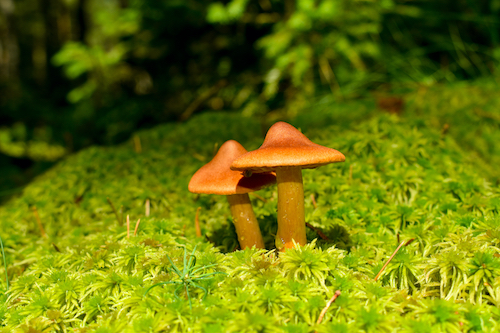

Other species considered wavy caps lookalikes are from the genera Cortinarius, Hypholoma, and Leratiomyces.
Cortinarius species are reported as lookalikes as some of these species have a blue coloring that fades over time, resembling blue bruising, while some (e.g. Cortinarius obtusus, Cortinarius rubellus) have a brown cap.
You definitely don’t want to eat the fairly rare but deadly Cortinarius rubellus (aptly named the “deadly webcap” mushroom). This is one of the world’s most poisonous mushrooms, as it contains the highly toxic compound orellanine, which can destroy the kidneys and liver. After consuming this mushroom, it can take up to two weeks for any symptoms to appear, by which time the damage has already been done.
Less poisonous but noteworthy mushrooms are Hypholoma species, which can also look similar to Psilocybe cyanescens. However, they grow in dense clusters, which is uncharacteristic of Psilocybe species. They tend to have brown caps with white stems and a purple-black spore print, and some can be poisonous.
Here’s What People Like and Don’t Like About Wavy Cap Mushrooms
What People Like About Wavy Caps:
- Potency: Wavy Caps are known for their considerable potency, making them sought-after for both substantial psychedelic experiences and microdosing.
- Unique Appearance: Their large flat brown caps with wavy edges make them visually distinctive and relatively easy to identify among enthusiasts.
- Prolific Growth: They often grow in large colonies, making the harvest fruitful.
- Psychedelic Experiences: Users report intense spiritual and mystical experiences, often described as powerful and visually stunning.
- Therapeutic Potential: Like other psilocybin mushrooms, Wavy Caps have potential benefits for mental health, including alleviating depression, anxiety, and promoting personal growth.
What People Don’t Like About Wavy Caps:
- Difficulty in Dosing: Due to their high potency, achieving the correct dosage can be challenging, leading to unexpectedly intense experiences.
- Wood-Lover’s Paralysis: A unique risk associated with Psilocybe species growing on wood, including Wavy Caps, which can lead to temporary muscle weakness or paralysis.
- Cultivation Challenges: While they can be cultivated, Wavy Caps prefer cold weather and specific conditions, which might be harder to replicate for indoor cultivation.
- Legal Issues: Psilocybin, the active compound in Wavy Caps, is illegal in many countries, posing a risk for those who forage, cultivate, or consume them.
- Look-alikes: While Wavy Caps have distinct features, they also have poisonous look-alikes, which can be dangerous for inexperienced foragers.
The experiences and preferences regarding Wavy Cap Mushrooms vary among individuals, with their potent effects and therapeutic potential being highly valued. However, the challenges in dosing, cultivation, and legal issues, along with the risks associated with look-alikes, are notable concerns.
Where Do Wavy Caps Grow?
The first step in identifying wavy caps in the wild is knowing where they grow. We can answer this question in two ways: by describing the kind of habitat you’ll find them in and by highlighting the countries — and the specific locations in those countries — where wavy caps grow.
Habitat
Psilocybe cyanescens grows primarily on wood chips, especially in and along the perimeter of mulched plant beds in urban areas. However, it can also grow on other lignin-rich substrates (lignin is an organic compound that strengthens the cell walls of plants, and is naturally produced in particular by woody plants).
Wavy cap mushrooms do not grow on substrate that is not lignin-rich. The mushrooms have been found in natural settings before (although most appear to be migrations from mulched plant beds). It is not typical for the species to grow on mulch made from bark.
Distribution
In the United States, Psilocybe cyanescens occurs mainly in the Pacific Northwest, but they can also be found in the San Francisco Bay Area, including in Golden Gate Park. You can also find these mushrooms in New Zealand, Western Europe, Central Europe, and parts of Western Asia such as Iran.
The range in which Psilocybe cyanescens grows is rapidly expanding, particularly in regions where it is not native, as the use of mulch to control weeds has become widespread. Wavy cap mushrooms have also been documented to fruit in Spring on the East Coast of the United States.
Although it has been believed that Psilocybe cyanescens’ native habitat is the coniferous woodlands of the north-western United States or coastal dunes in the Pacific North West, mycologist Elise Wakefield observed this mushroom growing in London’s Kew Gardens, which she described in 1942. An estimated 100,000 specimens have also been found growing on a racetrack in the south of England.
Fruiting occurs when the temperature in the area drops. In the San Francisco Bay Area, this means fruiting will tend to happen between late October and February, with fruiting in other areas usually occurring in fall.
How To Grow Wavy Cap Mushrooms
Growing Psilocybe cyanescens involves the same process as growing any other type of magic mushroom. You should refer to our guide on how to grow magic mushrooms at home for detailed instructions, but let’s offer a quick summary of everything you need and the steps you should take.
Wavy Cap Spores
First, you need to source some Psilocybe cyanescens spores. These are the reproductive cells that allow the mushroom to grow. Magic mushroom spores do not contain psilocybin, so they are not themselves illegal. But once they germinate and begin producing mycelium, psilocybin will be produced, making the end product illegal (since psilocybin is a controlled substance in most countries).
However, magic mushroom spores are illegal in California, Georgia, and Idaho. In the other 47 states, you’re free to buy and possess them.
There are different ways to get wavy cap spores.
One way is to extract your spores from the mushrooms themselves. The more popular option, though, is to buy them online from a vendor selling a spore syringe or print. The spore syringe is an oral syringe that contains just water and the wavy cap spores, while spore prints are little pieces of paper with the spores stamped onto them. The prints are dried and need to be rehydrated when you want to use them.
Steps For Growing Wavy Caps
It’s best to use our detailed guide for following the steps for growing wavy caps. You need the right ingredients, equipment, and hygiene supplies before getting started. The necessary steps will then be:
- Preparing the jars
- Inoculation
- Colonization
- Preparing the grow chamber
- Fruiting
- Harvesting
- Drying the mushrooms for long-term storage
FROM OUR PARTNER: Want to Save Money in the Long Run? Get Your Own Mushroom Grow Kit Here
Growing Psilocybe Cyanescens Outdoors
Our guide on growing magic mushrooms focused specifically on doing so at home. Yet growing wavy caps at home can be challenging, as these mushrooms require some specific conditions. But under the right climatic conditions, they can easily grow outdoors. If you want to grow wavy caps outdoors, you need to keep certain things in mind.
Psilocybe cyanescens grows on hardwoods such as Alder chips (Alnus rubra) and other woody mulches. These mushrooms will easily grow in urban garden beds mulched with a variety of wood chips. They like shady areas with good moisture, and are known to grow near rhododendrons, rose bushes, and azaleas.
Potency
As stated at the beginning of this article, Psilocybe cyanescens is a highly potent species of psilocybin mushroom. It is one of the most potent magic mushrooms, in fact. This is due to its high concentration of psychedelic alkaloids.
To get a sense of its potency, let’s take a look at the concentrations of psilocybin and psilocin in a few different species:
- Blue Angel (Psilocybe azurenscens): 1.78 percent psilocybin and 0.38 percent psilocin
- Liberty Cap (Psilocybe semilanceata): 0.98 percent psilocybin and 0.2 percent psilocin
- Wavy Cap (Psilocybe cyanescens): 0.85 percent psilocybin and 0.36 percent psilocin
- Magic Truffles (Psilocybe tampanensis): 0.68 percent psilocybin and 0.32 percent psilocin
- Golden Teacher (Psilocybe cubensis): 0.63 percent psilocybin and 0.60 percent
Because of their potency, flying saucer mushrooms are a popular option for microdosing — since you need a very small dose to achieve the intended effects.
Duration Of Wavy Caps Effects
A wavy cap mushroom trip will generally last between 4-6 hours. This duration is pretty consistent. In clinical trials involving psilocybin, most sessions will last up to six hours. After this time, the participants will no longer experience any psychedelic effects.
But the duration of a psilocybin experience for any individual depends on a few factors:
- Dosage. Taking a low dose of magic mushrooms could result in a trip lasting only a few hours, whereas consuming a high dose could lead to a six-hour experience.
- Method of Consumption. It takes around 30 minutes for shrooms to kick in. But you can quicken this process through lemon tekking — it is believed the citric acid in the lemon juice breaks down the mushroom material, saving your body some time it would otherwise spend breaking it down. The lemon tek method may result in a faster onset and a stronger and shorter journey than eating dried mushrooms as they are.
- Eating psilocybin mushrooms on an empty stomach can lead to a faster onset than consuming them on a full stomach.
- Cannabis may elongate a magic mushroom trip if you smoke it towards the end of the experience. This is because cannabis tends to potentiate the effects of psychedelics. However, not everyone may experience this effect.

